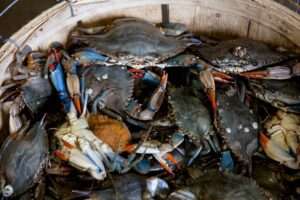Crabs are fascinating creatures that have evolved into a diverse array of species. They can be found in various aquatic habitats around the world, from the deep sea to freshwater rivers. Despite their abundance and variety, scientists are still puzzled by the question: Why does evolution keep making crabs? In this article, we will explore the intriguing nature of crab evolution, discussing possible reasons behind their evolutionary success and the mysteries that surround their existence. So let’s dive into the enigmatic world of crabs and unravel the secrets of their evolutionary journey.

Crab evolution is a mystery. Scientists have long wondered why this particular body plan has evolved so many times, in so many different lineages of crustaceans.
The Diversity of Crabs and Their Evolutionary Origins
Crab Taxonomy and Classification
Crabs belong to the crustacean family, which also includes lobsters, shrimp, and barnacles. They are classified under the order Decapoda, meaning “ten feet.” Crabs are characterized by their distinct body structure, with a hard exoskeleton, ten legs, and a pair of pincers.
Ancient Crab Fossils
Fossil records indicate that crabs have a long evolutionary history, dating back to the Early Jurassic period, approximately 170 million years ago. Some of the earliest crab fossils show remarkable similarities to their modern counterparts, suggesting that their basic body plan has remained relatively unchanged over millions of years.
Adaptations for Survival
Crabs have evolved a wide range of adaptations that contribute to their survival and success. Their flattened bodies and sideways walking enable them to move efficiently along the seafloor, while their hard exoskeleton provides protection from predators. The development of specialized appendages, such as their pincers, allows crabs to capture prey and defend themselves.
The Evolutionary Success of Crabs
Occupying Ecological Niches
One reason for the evolutionary success of crabs is their ability to occupy various ecological niches. Crabs have adapted to different habitats, including marine, freshwater, and terrestrial environments. This adaptability allows them to exploit diverse food sources and thrive in a wide range of conditions.
Versatile Diets
Crabs are known for their opportunistic feeding habits. They have the ability to consume a wide variety of food, including detritus, algae, mollusks, small fish, and even other crabs. This versatility in diet enables crabs to adapt to changing environmental conditions and increases their chances of survival.
Reproductive Strategies
Crabs have evolved diverse reproductive strategies to ensure the survival of their species. Some species reproduce through external fertilization, where females release eggs and males release sperm into the water, while others have internal fertilization. Additionally, some crabs exhibit complex mating behaviors and parental care, further enhancing their reproductive success.
Evolutionary Arms Race
Crabs have engaged in an evolutionary arms race with their predators and prey. Their hard exoskeletons, pincers, and camouflage adaptations have evolved in response to predation pressures. Similarly, their prey have developed various defense mechanisms, such as spines or toxins. This constant interaction between crabs and their environment drives the diversification and evolution of new crab species.
Crab evolution is a mystery. Scientists have long wondered why this particular body plan has evolved so many times, in so many different lineages of crustaceans.
One theory is that the crab shape is simply very efficient. The wide, flat body and short tail make crabs well-suited for burrowing, swimming, and walking. This versatility has allowed crabs to colonize a wide range of habitats, from the ocean floor to the treetops.
Another theory is that the crab shape provides some kind of evolutionary advantage. For example, the crab’s hard shell may offer protection from predators. Or, the crab’s ability to pinch with its claws may help it to catch prey.
Whatever the reason, it’s clear that evolution has a soft spot for crabs. These creatures have been around for over 400 million years, and they show no signs of going away anytime soon.
Why do crabs have ten legs:
Crabs belong to the Decapoda order, which translates to “ten feet.” The ten legs of crabs are a characteristic feature of their taxonomic group.
How do crabs molt:
Crabs periodically shed their exoskeletons in a process called molting. During molting, crabs grow a new exoskeleton underneath their old one, eventually shedding the old exoskeleton to allow for further growth.
Are all crabs edible:
While many crab species are considered edible and are consumed by humans, not all crabs are safe for consumption. Some crabs may contain toxins or be protected by conservation regulations.
Can crabs live on land:
While most crab species are primarily aquatic, some have adapted to terrestrial environments. Land crabs, such as the coconut crab, can survive on land for extended periods and breathe air.
Do crabs have a long lifespan:
The lifespan of crabs varies among species. Some smaller crab species may live for only a few years, while larger species, such as the Japanese spider crab, can live for several decades.
What are the threats to crab populations:
Crabs face various threats, including habitat loss, pollution, overfishing, and climate change. These factors can disrupt their ecosystems and impact their survival.
The evolution of crabs remains an intriguing and enigmatic topic in the scientific community. Their diverse adaptations, ecological success, and evolutionary arms race contribute to their continued existence and proliferation across different habitats. As scientists uncover more about crab evolution through fossil records, genetic studies, and ecological observations, we may gain a deeper understanding of the mechanisms driving their evolutionary success. Crabs continue to captivate us with their remarkable diversity and ability to thrive in various environments, leaving us with a sense of awe and curiosity about the mysteries that lie within their evolutionary journey.
